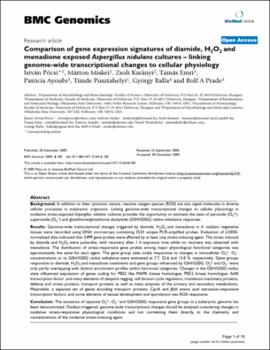| dc.contributor.author | Pocsi, Istvan | |
| dc.contributor.author | Miskei, Marton | |
| dc.contributor.author | Karanyi, Zsolt | |
| dc.contributor.author | Emri, Tamas | |
| dc.contributor.author | Ayoubi, Patricia | |
| dc.contributor.author | Pusztahelyi, Tunde | |
| dc.contributor.author | Balla, Gyorgy | |
| dc.contributor.author | Prade, Rolf A. | |
| dc.date.accessioned | 2018-11-09T21:10:49Z | |
| dc.date.available | 2018-11-09T21:10:49Z | |
| dc.date.issued | 2005-12-20 | |
| dc.identifier | oksd_pocsi_comparisonofge_2005 | |
| dc.identifier.citation | Pocsi, I., Miskei, M., Karanyi, Z., Emri, T., Ayoubi, P., Pusztahelyi, T., ... Prade, R. A. (2005). Comparison of gene expression signatures of diamide, H2O2 and menadione exposed Aspergillus nidulans cultures - Linking genome-wide transcriptional changes to cellular physiology. BMC Genomics, 6, Article 182. https://doi.org/10.1186/1471-2164-6-182 | |
| dc.identifier.uri | https://hdl.handle.net/11244/302060 | |
| dc.description.abstract | Background: In addition to their cytotoxic nature, reactive oxygen species (ROS) are also signal molecules in diverse cellular processes in eukaryotic organisms. Linking genome-wide transcriptional changes to cellular physiology in oxidative stress-exposed Aspergillus nidulans cultures provides the opportunity to estimate the sizes of peroxide (O2^2-), superoxide (O2^ -) and glutathione/glutathione disulphide (GSH/GSSG) redox imbalance responses. | |
| dc.description.abstract | Results: Genome-wide transcriptional changes triggered by diamide, H2O2 and menadione in A. nidulans vegetative tissues were recorded using DNA microarrays containing 3533 unique PCR-amplified probes. Evaluation of LOESS-normalized data indicated that 2499 gene probes were affected by at least one stress-inducing agent. The stress induced by diamide and H2O2 were pulse-like, with recovery after 1 h exposure time while no recovery was observed with menadione. The distribution of stress-responsive gene probes among major physiological functional categories was approximately the same for each agent. The gene group sizes solely responsive to changes in intracellular O2^2-, O2^ - concentrations or to GSH/GSSG redox imbalance were estimated at 7.7, 32.6 and 13.0 %, respectively. Gene groups responsive to diamide, H2O2 and menadione treatments and gene groups influenced by GSH/GSSG, O2^2- and O2^ - were only partly overlapping with distinct enrichment profiles within functional categories. Changes in the GSH/GSSG redox state influenced expression of genes coding for PBS2 like MAPK kinase homologue, PSK2 kinase homologue, AtfA transcription factor, and many elements of ubiquitin tagging, cell division cycle regulators, translation machinery proteins, defense and stress proteins, transport proteins as well as many enzymes of the primary and secondary metabolisms. Meanwhile, a separate set of genes encoding transport proteins, CpcA and JlbA amino acid starvation-responsive transcription factors, and some elements of sexual development and sporulation was ROS responsive. | |
| dc.description.abstract | Conclusion: The existence of separate O2^2-, O2^ - and GSH/GSSG responsive gene groups in a eukaryotic genome has been demonstrated. Oxidant-triggered, genome-wide transcriptional changes should be analyzed considering changes in oxidative stress-responsive physiological conditions and not correlating them directly to the chemistry and concentrations of the oxidative stress-inducing agent. | |
| dc.format | application/pdf | |
| dc.language | en_US | |
| dc.publisher | BioMed Central | |
| dc.rights | This material has been previously published. In the Oklahoma State University Library's institutional repository this version is made available through the open access principles and the terms of agreement/consent between the author(s) and the publisher. The permission policy on the use, reproduction or distribution of the material falls under fair use for educational, scholarship, and research purposes. Contact Digital Resources and Discovery Services at lib-dls@okstate.edu or 405-744-9161 for further information. | |
| dc.title | Comparison of gene expression signatures of diamide, H2O2 and menadione exposed Aspergillus nidulans cultures - Linking genome-wide transcriptional changes to cellular physiology | |
| osu.filename | oksd_pocsi_comparisonofge_2005.pdf | |
| dc.description.peerreview | Peer reviewed | |
| dc.identifier.doi | 10.1186/1471-2164-6-182 | |
| dc.description.department | Biochemistry and Molecular Biology | |
| dc.description.department | Microbiology and Molecular Genetics | |
| dc.type.genre | Article | |
| dc.type.material | Text | |
| dc.subject.keywords | gene probe | |
| dc.subject.keywords | responsive gene | |
| dc.subject.keywords | menadione | |
| dc.subject.keywords | diamide | |
| dc.subject.keywords | Ntf2 | |
